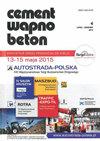Short glass fiber reinforced polymer concrete with addition of waste cathode-ray tube (CRT) glass
IF 0.5
4区 工程技术
Q4 CONSTRUCTION & BUILDING TECHNOLOGY
引用次数: 0
Abstract
This paper describes the use of CRT glass waste for the production of polymer concrete. The CRT glass was subjected to a multistage mechanical disintegration process, in a way that allowed obtaining grains smaller than 2 mm. A set of hybrid reinforced polymer concrete was produced by using: ground CRT glass, sand and cut glass fibers 4.5 mm and 12 mm long. The influence of the volume of fibers and the length of glass fibers on the properties of polymer concrete with 30% by volume of epoxy resin, acting as a binder was described. Tests of CRT glass were carried out, among others study of chemical composition, particle size distribution and analysis of grain morphology. For polymer concrete, the flexural strength and compressive strength were determined, and the open porosity, apparent density, and water absorption were examined. The test results showed that polymer concrete with the use of milled CRT glass is a good way to manage this problematic waste. The polymer concrete has several times better than traditional concretes and significantly lower porosity and water absorption, which makes this material advantageous in applications such as the production of thin-walled products and products exposed to water and chemical attack. The addition of chopped glass fibers leads to an increase in mechanical properties and also protects the material against rapid disintegration after exceeding the maximum tresses, which is extremely important for the safety of use of the structure in the event of a failure.短玻璃纤维增强聚合物混凝土添加废弃阴极射线管(CRT)玻璃
本文介绍了利用CRT玻璃废料生产聚合物混凝土的情况。CRT玻璃经受了多阶段的机械解体过程,以一种允许获得小于2毫米颗粒的方式。采用磨碎的CRT玻璃、砂和切割的玻璃纤维(长4.5 mm和12 mm)制备了一套混合增强聚合物混凝土。研究了以30%体积比的环氧树脂为粘结剂时,纤维体积和玻璃纤维长度对聚合物混凝土性能的影响。对阴极射线管玻璃进行了化学成分、粒度分布和晶粒形貌分析等测试。测定了聚合物混凝土的抗折强度和抗压强度,并对其开孔率、表观密度和吸水率进行了测试。试验结果表明,聚合物混凝土与磨铣CRT玻璃的使用是一个很好的方法来管理这一问题废物。聚合物混凝土的性能比传统混凝土好几倍,并且孔隙率和吸水性显著降低,这使得这种材料在薄壁产品和易受水和化学侵蚀的产品的生产中具有优势。添加短切玻璃纤维可以提高机械性能,并保护材料在超过最大应力后不会迅速分解,这对于发生故障时结构的使用安全至关重要。
本文章由计算机程序翻译,如有差异,请以英文原文为准。
求助全文
约1分钟内获得全文
求助全文
来源期刊

Cement Wapno Beton
CONSTRUCTION & BUILDING TECHNOLOGY-MATERIALS SCIENCE, COMPOSITES
CiteScore
1.30
自引率
28.60%
发文量
0
审稿时长
>12 weeks
期刊介绍:
The Publisher of the scientific bimonthly of international circulation, entitled "Cement-Wapno-Beton" ["Cement-Lime-Concrete"], is the Fundacja Cement, Wapno, Beton [Foundation Cement, Lime, Concrete]. The periodical is dedicated to the issues concerning mineral setting materials and concrete. It is concerned with the publication of academic and research works from the field of chemistry and technology of building setting materials and concrete
 求助内容:
求助内容: 应助结果提醒方式:
应助结果提醒方式:


